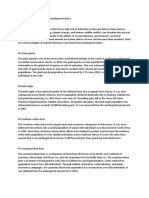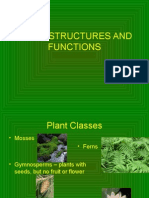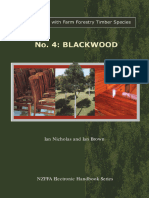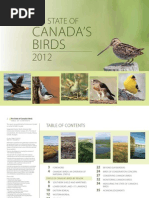Habitat Requirements Food: Number 10
Habitat Requirements Food: Number 10
Uploaded by
lastoutriderCopyright:
Available Formats
Habitat Requirements Food: Number 10
Habitat Requirements Food: Number 10
Uploaded by
lastoutriderOriginal Description:
Original Title
Copyright
Available Formats
Share this document
Did you find this document useful?
Is this content inappropriate?
Copyright:
Available Formats
Habitat Requirements Food: Number 10
Habitat Requirements Food: Number 10
Uploaded by
lastoutriderCopyright:
Available Formats
Number 10
HABITAT REQUIREMENTS
Black bears are present in the
southern Appalachian Mountains
and the coastal bays and swamps of
North Carolina. The best habitat is
provided in old forests dominated by
hardwoods containing a variety of
mast-producing tree and shrub
species. Bears typically require
extensive, rugged country with
dense thickets, swamps, bays, or
rock outcrops, and room to travel
widely with little contact with
agriculture or livestock production
areas.
Bears occasionally will
cause
damage
in
livestock
operations,
apple
orchards,
cornfields or by feeding on the inner
bark of some desired tree species.
Food
Black bears are omnivorous. The bulk
of their diet is hard and soft mast,
insects, animal matter and succulent
plants. The amount and types of food
eaten by bears varies according to
seasonal activities and food availability.
Pre-denning
(Aug - Nov)
Hard Mast
Blackgum
Holly Berries
Black Cherry
Dogwood Berries
Sassafras
Persimmon
Insects
Animals
Pokeberry
Greenbrier
Denning*
(Dec - Mar)
Hard Mast
Greenbrier
Corn
Gallberries
*Some bears may be active throughout
the winter denning season.
Distributed in furtherance
of the acts of Congress of
May 8 and June 30, 1914.
Employment and program
opportunities are offered to
all people regardless of
race, color, national origin,
sex, age, or disability.
North Carolina State
University, North Carolina
A & T State University, US
Department of Agriculture,
and local governments
Post-denning
(Apr & May)
Arrow Arum
Greenbrier
Grasses
Pokeberry
Squaw Root
Tree Cambium
Insects
Animals
Breeding
(Jun & Jul)
Blackberry
Huckleberry
Blueberry
Serviceberry
Viburnum
Insects
Animals
North Carolina
Cooperative Extension Service
North Carolina State University
College of Agriculture & Life Sciences
College of Forest Resources
Page 2
Cover
Bear have keen senses of smell and hearing,
but their vision is less acute. Near areas of
human activity, they often bed down in dense
thickets in daytime and do much of their
moving at sunrise and sunset. Small bears
sometimes use trees for resting places.
Bears go into winter dormancy from
December through March in the southern
Appalachians.
Escape Cover
Rugged terrain such as steep, rocky,
mountainous slopes
Mountainsides laced with laurel,
rhododendron, grapes, greenbrier
or other thickets
Extensive areas with minimal human
disturbance
Large swamps with dense briars and
canes, stream channels and standing
water
Carolina bays and pocosins
Home Range
Typical black bear densities range from
one bear per square mile to one bear per
seven square miles. The home range of
bears in the Southeast ranges from 6 to 19
square miles for females to 18 to 160
square miles for males. Home ranges
must include den sites, food, water and
cover for adults and young. Home ranges
and bear densities may vary considerably
depending on available food sources.
Mast shortages may result in considerable
wandering, so other important fall and
winter foods should be maintained at high
levels to deter movement into areas where
bears are more vulnerable or troublesome.
The most important element of escape cover
is protection from people, dogs, and off-road
vehicles.
Water
Bears require water daily. Two or more
sources of permanent open water per square
mile of range should be available.
N.C. Cooperative Extension Service
Working With Wildlife # 10 - Black Bear
Page 3
TIPS FOR IMPROVING
BLACK BEAR HABITAT
General:
Provide large expanses of mature
forest, predominantly mast-producing
hardwood
Protect streamside zones
Rotation:
Manage for long rotations in hardwood
types (60 years or more)
Limit harvesting to 25 acre stands or
less
Retain bottomland
swamp
sites
hardwood
and
Regeneration:
Avoid extensive clearcutting and seed
tree regeneration methods
Intermediate Treatments:
Thin occasionally to encourage crown
growth, yet avoid frequent disturbances,
limit use of herbicides
Regenerate no more than 10% of total
management area in a 10 year period
Burn frequently (3 to 5 years) to
encourage herbaceous growth
Direct Improvements:
Retain trees with large cavities and
retain
sheltering stems around
openings
Plant open areas with fruiting shrubs or
grains
Plant or encourage growth of fruit and
nut trees
Select and retain large diameter trees
with potential to develop large cavities
Limit access and
management area
disturbance
to
Species That Benefit From Black Bear Management
Numerous game and nongame species benefit from black bear management. Rather than
focusing on a single species, habitat management plans should emphasize the communities which
include black bears. The following species benefit from black bear management:
Gray Squirrel
White-tailed Deer
Great-horned Owl
Pileated Woodpecker
Raccoon
Wood Duck
American Redstart
Ruffed Grouse
Prepared by:
Michael S. Mitchell, Graduate Research Assistant,
Mark A. Megalos, Extension Forestry Specialist,
Edwin J. Jones, Department Extension Leader
N.C. Cooperative Extension Service
Working With Wildlife # 10 - Black Bear
Page 4
Cost share assistance may be available through the Stewardship Incentive Program for these
practices. See your Wildlife Biologist, Forester, or Extension Agent for more information about
the Forest Stewardship Program.
Other Wildlife Notes Available:
No. 1 - Endangered Species
No. 14 - Snags and Downed Logs
No. 2 - Eastern Gray Squirrel
No. 15 - Managing Edges for Wildlife
No. 3 - White-tailed Deer
No. 16 - Building Songbird Boxes
No. 4 - Songbirds
No. 17 - Woodland Wildlife Nest Boxes
No. 5 - Wild Turkey
No. 18 - Low Cost Habitat Improvements
No. 6 - Wood Duck
No. 19 - Pools for Amphibians
No. 7 - Cottontail Rabbit
No. 20 - Hummingbirds and Butterflies
No. 8 - Bobwhite Quail
No. 21 - Bats
No. 9 - Ruffed Grouse
No. 22 - Owls
No. 10 - Black Bear
No. 23 - Managing Beaver Ponds
No. 11 - Raccoon
No. 24 - Herbaceous Plants for Wildlife
No. 12 - Mourning Dove
No. 25 - SIP Wildlife Opportunities
No. 13 - Wildlife Terms
FOREST STEWARDSHIP
a cooperative program for
improving and maintaining all of the
resources on private forestland
9-94-4M-WWW-10
N.C. Cooperative Extension Service
Working With Wildlife # 10 - Black Bear
You might also like
- Donald L. Grebner, Pete Bettinger, Jacek Siry, Kevin Boston - Introduction To Forestry and Natural Resources-Academic Press (2021)Document513 pagesDonald L. Grebner, Pete Bettinger, Jacek Siry, Kevin Boston - Introduction To Forestry and Natural Resources-Academic Press (2021)Jebby EtheimNo ratings yet
- Exotic Breeds of Hoofstock TeacherDocument13 pagesExotic Breeds of Hoofstock Teacherapi-282746420No ratings yet
- Science of The Total Environment: Soil Microbial Biomass: A Key Soil Driver in Management of Ecosystem FunctioningDocument5 pagesScience of The Total Environment: Soil Microbial Biomass: A Key Soil Driver in Management of Ecosystem FunctioningERBIN ROJASNo ratings yet
- Habitat Requirements: Number 9Document4 pagesHabitat Requirements: Number 9lastoutriderNo ratings yet
- Habitat Requirements Food: Number 5Document4 pagesHabitat Requirements Food: Number 5lastoutriderNo ratings yet
- Habitat Requirements Food: Number 6Document4 pagesHabitat Requirements Food: Number 6lastoutriderNo ratings yet
- WWW 22Document4 pagesWWW 22lastoutriderNo ratings yet
- Habitat Requirements Cover: Rabbit FoodsDocument4 pagesHabitat Requirements Cover: Rabbit FoodslastoutriderNo ratings yet
- WWW 11Document4 pagesWWW 11lastoutriderNo ratings yet
- Habitat Requirements Food: Seasonal Foods of Gray SquirrelsDocument4 pagesHabitat Requirements Food: Seasonal Foods of Gray SquirrelslastoutriderNo ratings yet
- Key Foods: Habitat RequirementsDocument4 pagesKey Foods: Habitat RequirementslastoutriderNo ratings yet
- Mountain Lions: Damage Prevention and Control MethodsDocument8 pagesMountain Lions: Damage Prevention and Control MethodsajaygarasiyaNo ratings yet
- Trees: Edges Are ImportantDocument4 pagesTrees: Edges Are ImportantlastoutriderNo ratings yet
- WWW 08Document4 pagesWWW 08lastoutriderNo ratings yet
- Key Habitat Areas: Number 18Document4 pagesKey Habitat Areas: Number 18lastoutriderNo ratings yet
- White-Tailed DeerDocument2 pagesWhite-Tailed DeerConnecticut Wildlife Publication LibraryNo ratings yet
- IE2 Course Pack - Reading MaterialDocument15 pagesIE2 Course Pack - Reading MaterialKim Hoang TaNo ratings yet
- Pest Animal Fact Sheet: ImpactsDocument2 pagesPest Animal Fact Sheet: ImpactsBudi AfriyansyahNo ratings yet
- Prairie Dog ControlDocument4 pagesPrairie Dog ControlrationalsilenceartistNo ratings yet
- Delmarva Peninsula Fox Squirrel: Sciurus Niger CinereusDocument2 pagesDelmarva Peninsula Fox Squirrel: Sciurus Niger CinereusStefan PreNo ratings yet
- The Buck Stops HereDocument2 pagesThe Buck Stops HereVFFanNo ratings yet
- Grassland GrasslandDocument9 pagesGrassland GrasslandMahipal SinghNo ratings yet
- Pools For Amphibians: Number 19Document4 pagesPools For Amphibians: Number 19lastoutriderNo ratings yet
- Blank 5Document13 pagesBlank 5Shehab IbrahimNo ratings yet
- Endangered Animals Found in PeruDocument1 pageEndangered Animals Found in PeruCrisanto Calla ChacónNo ratings yet
- Ex Situ Conservation-TapirDocument16 pagesEx Situ Conservation-Tapirizza115No ratings yet
- Endangered Animals - MarineDocument3 pagesEndangered Animals - MarineJoan JohnNo ratings yet
- Tundra Deciduous Forest Savanna Taiga Chaparral Rainforest Grasslands Desert AlpineDocument20 pagesTundra Deciduous Forest Savanna Taiga Chaparral Rainforest Grasslands Desert Alpinehusain07No ratings yet
- Red-Footed TortoiseDocument2 pagesRed-Footed Tortoiseapi-379174072No ratings yet
- What If There Were No Gray Wolves?: A Book About the Temperate Forest EcosystemFrom EverandWhat If There Were No Gray Wolves?: A Book About the Temperate Forest EcosystemNo ratings yet
- Mammals of SPRDocument2 pagesMammals of SPRrehan ul haqNo ratings yet
- Black Bear Fact Sheet (RI DEM)Document5 pagesBlack Bear Fact Sheet (RI DEM)Frank MaradiagaNo ratings yet
- Calling All Wildlife!Document12 pagesCalling All Wildlife!riki187No ratings yet
- Document MightDocument3 pagesDocument MightharshmichaNo ratings yet
- Endangered SpeciesDocument2 pagesEndangered SpeciesspiritusNo ratings yet
- Wild Animals List and DescriptionsDocument3 pagesWild Animals List and Descriptionsalexaroma2008No ratings yet
- Deer, (Family Cervidae), Any of 43 Species of Hoofed: Ruminants ArtiodactylaDocument12 pagesDeer, (Family Cervidae), Any of 43 Species of Hoofed: Ruminants Artiodactylajoel lopezNo ratings yet
- Ursul enDocument20 pagesUrsul enBordea MarilenaNo ratings yet
- Wild Pigs PDFDocument6 pagesWild Pigs PDFspaceskipperNo ratings yet
- The Endangered Mammals from Around the World : Animal Books for Kids Age 9-12 | Children's Animal BooksFrom EverandThe Endangered Mammals from Around the World : Animal Books for Kids Age 9-12 | Children's Animal BooksNo ratings yet
- Endangerd AnimalsDocument2 pagesEndangerd AnimalsCandy KittyNo ratings yet
- Oso AndinoDocument8 pagesOso AndinoJeferson Javier Mamani100% (1)
- Green and White Sustainability Modern PresentationDocument11 pagesGreen and White Sustainability Modern PresentationAubrey LNo ratings yet
- What Is A UNESCO Global GeoparkDocument5 pagesWhat Is A UNESCO Global GeoparktivaaNo ratings yet
- InglesDocument2 pagesInglesvilcapumadaniel34No ratings yet
- Endangered Animals in PeruDocument9 pagesEndangered Animals in Peruivan rivero atanacioNo ratings yet
- Document MightDocument4 pagesDocument MightharshmichaNo ratings yet
- Endangered Species ProjectDocument17 pagesEndangered Species ProjectMikaela SunNo ratings yet
- Examples of Keystone SpeciesDocument3 pagesExamples of Keystone SpeciesWENCY FLYNN SINGCAY100% (1)
- Wildlife Conservation - SCI PROJECTDocument21 pagesWildlife Conservation - SCI PROJECTanjalipathak213No ratings yet
- Jan 2004-3 San Diego SierraDocument2 pagesJan 2004-3 San Diego SierraU8x58No ratings yet
- Danta de ParamoDocument5 pagesDanta de ParamoFabian SalgadoNo ratings yet
- Forests and WildlifeDocument24 pagesForests and WildlifeDebasish MahapatraNo ratings yet
- 02. Wildlife and TourismDocument9 pages02. Wildlife and Tourismsamuelsifa003No ratings yet
- Sustaining Biodiversity: The Species (Ex-Situ) ApproachDocument63 pagesSustaining Biodiversity: The Species (Ex-Situ) ApproachbiancaNo ratings yet
- Mantled Howler MonkeyDocument4 pagesMantled Howler MonkeyRamkumar NarayananNo ratings yet
- Wilds of the United States: The Animals' Survival Field GuideFrom EverandWilds of the United States: The Animals' Survival Field GuideNo ratings yet
- By Nicholas ManfrediDocument54 pagesBy Nicholas Manfrediman1313pNo ratings yet
- ORAL PROYECT 4 - Oso de AnteojosDocument2 pagesORAL PROYECT 4 - Oso de AnteojosCatherine Magnolia Carrasco SuasacaNo ratings yet
- Vulnerability To ExtinctionDocument25 pagesVulnerability To ExtinctionSoh Yi HanNo ratings yet
- Amara W: Mindoro War y PigDocument1 pageAmara W: Mindoro War y Piglaurence libedNo ratings yet
- Virginia Cooperative Extension: InstructionsDocument2 pagesVirginia Cooperative Extension: InstructionslastoutriderNo ratings yet
- VA 4H TreeID 5Document1 pageVA 4H TreeID 5lastoutriderNo ratings yet
- Virginia 4-H School Enrichment: ForestryDocument52 pagesVirginia 4-H School Enrichment: ForestrylastoutriderNo ratings yet
- Checklist of Virginia Trees and Their Uses: Note To 4-H Member GlossaryDocument2 pagesChecklist of Virginia Trees and Their Uses: Note To 4-H Member GlossarylastoutriderNo ratings yet
- Trees in Your Backyard: 4-H Forestry ProjectsDocument12 pagesTrees in Your Backyard: 4-H Forestry ProjectslastoutriderNo ratings yet
- Virginia Cooperative Extension: K T T I C #2Document1 pageVirginia Cooperative Extension: K T T I C #2lastoutriderNo ratings yet
- Cavity Nesters Need Homes: Number 17Document4 pagesCavity Nesters Need Homes: Number 17lastoutriderNo ratings yet
- Habitat Requirements Food: Seasonal Foods of Gray SquirrelsDocument4 pagesHabitat Requirements Food: Seasonal Foods of Gray SquirrelslastoutriderNo ratings yet
- Key Foods: Habitat RequirementsDocument4 pagesKey Foods: Habitat RequirementslastoutriderNo ratings yet
- Trees: Edges Are ImportantDocument4 pagesTrees: Edges Are ImportantlastoutriderNo ratings yet
- WHEPManual 2003Document52 pagesWHEPManual 2003lastoutriderNo ratings yet
- WWW 11Document4 pagesWWW 11lastoutriderNo ratings yet
- WWW 08Document4 pagesWWW 08lastoutriderNo ratings yet
- Pools For Amphibians: Number 19Document4 pagesPools For Amphibians: Number 19lastoutriderNo ratings yet
- Biological Diversity Community: CoverDocument4 pagesBiological Diversity Community: CoverlastoutriderNo ratings yet
- Key Habitat Areas: Number 18Document4 pagesKey Habitat Areas: Number 18lastoutriderNo ratings yet
- Sexual Reproduction in PlantsDocument47 pagesSexual Reproduction in PlantslastoutriderNo ratings yet
- Flying Mammals: Number 21Document4 pagesFlying Mammals: Number 21lastoutriderNo ratings yet
- Beaver Pond Benefits: Number 23Document4 pagesBeaver Pond Benefits: Number 23lastoutriderNo ratings yet
- Mowing and Brush Chopping: Number 24Document4 pagesMowing and Brush Chopping: Number 24lastoutriderNo ratings yet
- Introduction To Plant ReproductionDocument27 pagesIntroduction To Plant ReproductionlastoutriderNo ratings yet
- Plant Structures and FunctionsDocument49 pagesPlant Structures and FunctionslastoutriderNo ratings yet
- Cell Division: MeiosisDocument20 pagesCell Division: MeiosislastoutriderNo ratings yet
- Plant NutrientsDocument22 pagesPlant NutrientslastoutriderNo ratings yet
- GerminatDocument13 pagesGerminatlastoutriderNo ratings yet
- Fardin & Roksana Ecological Disturbance PresentationDocument10 pagesFardin & Roksana Ecological Disturbance PresentationZahid khanNo ratings yet
- Public CommunicationDocument6 pagesPublic CommunicationOjjasvita KhurcheNo ratings yet
- Restoration EcologyDocument5 pagesRestoration EcologyjerromeobrusasNo ratings yet
- Blackwood Handbook 2edDocument136 pagesBlackwood Handbook 2edharry.liveseyNo ratings yet
- APES Unit 4 PowerPointDocument48 pagesAPES Unit 4 PowerPointJJ AlmagroNo ratings yet
- Holcim Quarry Rehab ExperienceDocument72 pagesHolcim Quarry Rehab ExperiencefarahNo ratings yet
- Climate - Change - Meets - Habitat - Fragmentation - TIBI PDFDocument13 pagesClimate - Change - Meets - Habitat - Fragmentation - TIBI PDFStefana BernatNo ratings yet
- Consortium Tech SheetDocument7 pagesConsortium Tech SheetmehNo ratings yet
- Forest Health and VitalityDocument15 pagesForest Health and VitalityShrawan GiriNo ratings yet
- FieldVegHandbookV2ExplanNotes Ap14Document89 pagesFieldVegHandbookV2ExplanNotes Ap14mwesigaderrick557No ratings yet
- Anthropogenic Modification of EstuariesDocument271 pagesAnthropogenic Modification of EstuariessoaresacpNo ratings yet
- Ecological NetworkDocument11 pagesEcological NetworkDaisy100% (1)
- ijhs_v5_n2Document955 pagesijhs_v5_n2chris slatcherNo ratings yet
- Ecology of Marine Sediments 2nd Edition John S. Gray Download PDFDocument84 pagesEcology of Marine Sediments 2nd Edition John S. Gray Download PDFshordybarsh100% (4)
- Wilber Montejo-Mayo, Ek Del-Val, Mariela Gomez-Romero, Erick de La Barrera, y Roberto Lindig-CisnerosDocument9 pagesWilber Montejo-Mayo, Ek Del-Val, Mariela Gomez-Romero, Erick de La Barrera, y Roberto Lindig-CisnerosDNo ratings yet
- State of Canada's Birds 2012Document36 pagesState of Canada's Birds 2012Trevor PritchardNo ratings yet
- EthiDocument212 pagesEthiDani LacatusuNo ratings yet
- Disturbance EcologyDocument1 pageDisturbance EcologyHartford CourantNo ratings yet
- Wildlife Census TechniquesDocument66 pagesWildlife Census TechniquesMaya Fadhillah100% (1)
- Quiz 3Document3 pagesQuiz 3vaibhavNo ratings yet
- Guide To Artificial Perches For BirdsDocument9 pagesGuide To Artificial Perches For BirdsOmar RodriguezNo ratings yet
- Forestry Model Exam 2024Document13 pagesForestry Model Exam 2024tame kibruNo ratings yet
- Impact of Hydro Power Project On Hingol National Park's BiodiversityDocument23 pagesImpact of Hydro Power Project On Hingol National Park's BiodiversityMohammad Yahya MusakhelNo ratings yet
- PHD Thesis PDFDocument229 pagesPHD Thesis PDFUrvashi SinghNo ratings yet
- Ecosystem DiversityDocument7 pagesEcosystem DiversityJay Bianca Abera AlistadoNo ratings yet
- Module 2 (People and The Earth's Ecosystem)Document11 pagesModule 2 (People and The Earth's Ecosystem)chris ian0% (2)
- Principles of DendrochronologyDocument6 pagesPrinciples of Dendrochronologycristina261293No ratings yet
- Presliai 1Document9 pagesPresliai 1Gopal PatelNo ratings yet











































































































